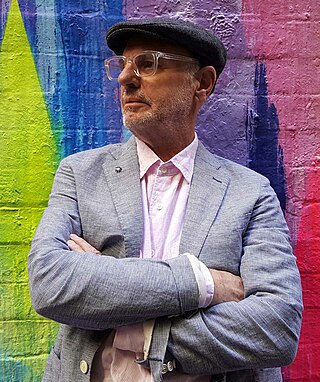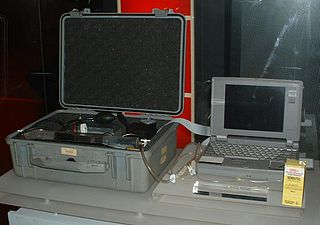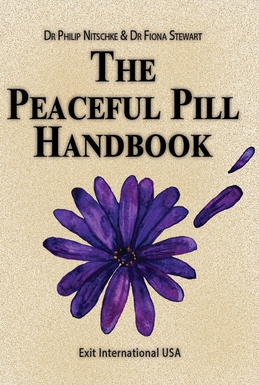Euthanasia is the practise of intentionally ending life to eliminate pain and suffering.

Assisted suicide – alternately referred to as medical aid in dying – means a procedure in which people take medications to end their own lives with the help of others, usually medical professionals. The term usually refers to physician-assisted suicide (PAS), which is an end of life measure for a person suffering a painful, terminal illness. Once it is determined that the person's situation qualifies under the physician-assisted suicide laws for that location, the physician's assistance is usually limited to writing a prescription for a lethal dose of drugs.

Philip Haig Nitschke is an Australian humanist, author, former physician, and founder and director of the pro-euthanasia group Exit International. He campaigned successfully to have a legal euthanasia law passed in Australia's Northern Territory and assisted four people in ending their lives before the law was overturned by the Government of Australia. Nitschke was the first doctor in the world to administer a legal, voluntary, lethal injection, after which the patient activated the syringe using a computer. Nitschke states that he and his group are regularly subject to harassment by authorities. In 2015, Nitschke burned his medical practising certificate in response to what he saw as onerous conditions that violated his right to free speech, imposed on him by the Medical Board of Australia. Nitschke has been referred to in the media as "Dr Death" or "the Elon Musk of assisted suicide".

Liquid nitrogen—LN2—is nitrogen in a liquid state at low temperature. Liquid nitrogen has a boiling point of about −196 °C (−321 °F; 77 K). It is produced industrially by fractional distillation of liquid air. It is a colorless, mobile liquid whose viscosity is about one tenth that of acetone. Liquid nitrogen is widely used as a coolant.

The Rights of the Terminally Ill Act 1995 (NT) was a controversial law legalising euthanasia in the Northern Territory of Australia, which was passed by the territory's Parliament in 1995. The Act was passed by the Northern Territory Legislative Assembly on 25 May 1995 by a vote of 15 to 10, received the Administrator's assent on 16 June 1995, and entered into force on 1 July 1996. A year later, a repeal bill was brought before the Northern Territory Parliament in August 1996, but was defeated by 14 votes to 11.
Pentobarbital (US) or pentobarbitone is a short-acting barbiturate typically used as a sedative, a preanesthetic, and to control convulsions in emergencies. It can also be used for short-term treatment of insomnia but has been largely replaced by the benzodiazepine family of drugs.

Final Exit is a 1991 book written by Derek Humphry, a British-born American journalist, author, and assisted suicide advocate who co-founded the now-defunct Hemlock Society in 1980 and co-founded the Final Exit Network in 2004. The book was first published in 1991 by the Hemlock Society US in hardback. The following year, its 2nd edition was published by Dell in trade paperback. The current updated edition was published in 2010.
Voluntary euthanasia is the ending of a person's life at their request in order to relieve them of suffering. Voluntary euthanasia and physician-assisted suicide (PAS) have been the focus of intense debate in recent years.
Inert gas asphyxiation is a form of asphyxiation which results from breathing a physiologically inert gas in the absence of oxygen, or a low amount of oxygen, rather than atmospheric air. Examples of physiologically inert gases, which have caused accidental or deliberate death by this mechanism, are argon, helium, nitrogen and methane. The term "physiologically inert" is used to indicate a gas which has no toxic or anesthetic properties and does not act upon the heart or hemoglobin. Instead, the gas acts as a simple diluent to reduce the oxygen concentration in inspired gas and blood to dangerously low levels, thereby eventually depriving all cells in the body of oxygen.

Dignitas is a Swiss nonprofit organization providing physician-assisted suicide to members with terminal illness or severe physical or mental illness, supported by independent Swiss doctors. By the end of 2020, they had assisted 3,248 people with suicide at home within Switzerland and at Dignitas' house/flat near Zürich. They provide advisory work on palliative care, health care advance directives, and suicide attempt prevention, and legislation for right-to-die laws around the world.

Exit International is an international non-profit organisation advocating legalisation of voluntary euthanasia and assisted suicide. It was previously known as the Voluntary Euthanasia Research Foundation.

The legality of euthanasia varies depending on the country. Efforts to change government policies on euthanasia of humans in the 20th and 21st centuries have met limited success in Western countries. Human euthanasia policies have also been developed by a variety of NGOs, most notably medical associations and advocacy organizations. As of 2023, euthanasia is legal in Belgium, Canada, Colombia, Luxembourg, the Netherlands, New Zealand, Portugal, Spain and all six states of Australia. Euthanasia was briefly legal in the Northern Territory between 1996 and 1997, but was overturned by a federal law. In 2021, a Peruvian court allowed euthanasia for a single person, Ana Estrada.

The Peaceful Pill Handbook is a book setting out information on assisted suicide and voluntary euthanasia. Written by the Australian doctor Philip Nitschke and lawyer Fiona Stewart, it was originally published in the U.S. in 2006. A German edition of the print book—Die Friedliche Pille—was published in 2011. A French edition—La Pilule Paisible—was published in June 2015. An Italian edition—La pillola della quiete—was published in 2018.
A euthanasia device is a machine engineered to allow an individual to die quickly with minimal pain. The most common devices are those designed to help terminally ill people die by voluntary euthanasia or assisted suicide without prolonged pain. They may be operated by a second party, such as a physician, or by the person wishing to die. There is an ongoing debate on the ethics of euthanasia and the use of euthanasia devices.
Suicide tourism, or euthanasia tourism, is the practice of potential suicide candidates travelling to a jurisdiction to die by suicide or assisted suicide which is legal in some jurisdictions, or the practice of travelling to a jurisdiction in order to obtain drugs that can aid in the process of ending one's own life.
Euthanasia became legal in New Zealand when the End of Life Choice Act 2019 took full effect on 7 November 2021. It is illegal to "aid and abet suicide" under Section 179 of the New Zealand Crimes Act 1961. The clauses of this act make it an offence to "incite, procure or counsel" and "aid and abet" someone else to commit suicide, regardless of whether a suicide attempt is made or not. Section 179 covers both coercion to undertake assisted suicide and true suicide, such as that caused by bullying. This will not change under the End of Life Choices Act 2019, which has provisions on coercion of terminally ill people.
A suicide bag, also known as an exit bag or hood, is part of a euthanasia device consisting of a large plastic bag with a drawcord used to commit suicide through inert gas asphyxiation. It is usually used in conjunction with a flow of an inert gas that is lighter or less dense than air, like helium or nitrogen. Continuing to breathe expels carbon dioxide and this prevents the panic, sense of suffocation and struggling before unconsciousness, known as the hypercapnic alarm response caused by the presence of high carbon dioxide concentrations in the blood. This method also makes the direct cause of death difficult to trace if the bag and gas canister are removed before the death is investigated. While asphyxiation by helium can be detected at autopsy, there is currently no test that can detect asphyxiation by nitrogen. For this reason, nitrogen is commonly the preferred choice for people who do not want the cause of death established.
The Voluntary Euthanasia Party (VEP) was a minor political party in Australia, founded in early 2013 by Corey McCann to advocate for legislative change to allow voluntary euthanasia in Australia. The party's inception was strongly supported by Dr Philip Nitschke, director of Exit International and Richard Mills, then President of Dying with Dignity NSW.

Last Cab to Darwin is a 2015 Australian film directed by Jeremy Sims and written by Sims and Reg Cribb. Based on Cribb's 2003 play of the same name, it stars Michael Caton, Ningali Lawford, Mark Coles Smith, Emma Hamilton and Jacki Weaver, who was in the original cast of the play. Like the play, the film was inspired by the true story of Max Bell, a taxi driver who traveled from Broken Hill to Darwin to seek euthanasia after he was diagnosed with a terminal illness. The film received positive reviews and was nominated for nine AACTA Awards, winning Best Actor for Caton and Best Adapted Screenplay for Sims and Cribb.

Pegasos Swiss Association or Pegasos is a non-profit group based in Basel, Switzerland with a minimal-bureaucracy approach to assisted suicide.. In Greek mythology, Pegasus is a winged horse that the Pegasos association sees as symbolizing how patients speedily escape gravity on their final journey.











